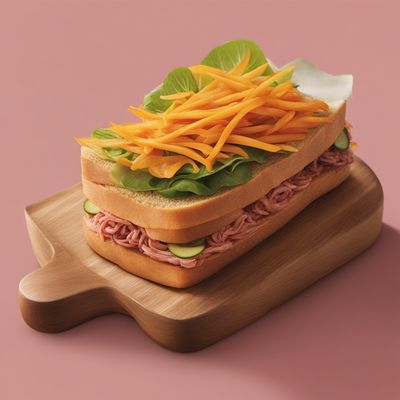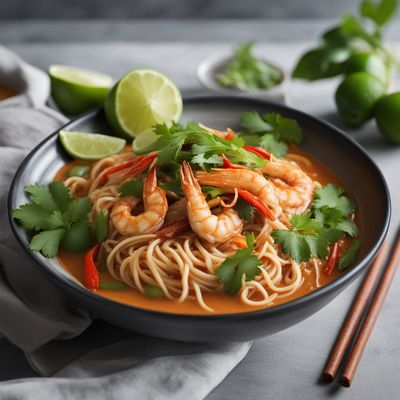
Ingredient
Galangal roots
The Exotic Spice: Galangal Roots
Galangal roots have a knobby appearance with a pale yellowish-brown skin and a firm, fibrous texture. They have a spicy and peppery flavor with hints of citrus and pine, similar to ginger but more complex. When sliced or grated, galangal roots release a strong and fragrant aroma that is both refreshing and warming.
Origins and history
Galangal roots have a long history of use in Southeast Asian countries like Thailand, Indonesia, and Malaysia. They are a staple ingredient in traditional dishes like curries, soups, and stir-fries, where they add a distinctive flavor and aroma. Galangal roots are also valued for their medicinal properties and are often used in herbal remedies to treat digestive issues, reduce inflammation, and boost the immune system.
Nutritional information
Galangal roots are low in calories and fat but rich in antioxidants and essential oils. They contain compounds like gingerol and galangol, which have anti-inflammatory and antimicrobial properties. Galangal roots are also a good source of dietary fiber, vitamins, and minerals, including iron, potassium, and manganese.
How to select
Choose galangal roots that are firm and free from blemishes or mold. Look for roots with a smooth skin and a fresh, strong aroma. Avoid galangal roots that feel soft or have wrinkled skin, as they may be old or dried out. If fresh galangal roots are not available, you can also find them in dried or powdered form, although the flavor may be slightly different.
Storage recommendations
To keep galangal roots fresh, store them in a cool, dry place away from direct sunlight. If you have purchased fresh galangal roots, you can also store them in the refrigerator wrapped in a paper towel or placed in a resealable bag. Dried galangal roots should be kept in an airtight container in a cool, dark pantry.
Preparation tips
Before using galangal roots, peel off the tough outer skin using a vegetable peeler or a knife. The inner flesh can then be sliced, grated, or pounded into a paste using a mortar and pestle. Galangal roots are commonly used in curries, soups, and stir-fries, where they infuse the dish with their unique flavor. They can also be added to marinades, sauces, and herbal teas for an aromatic twist. If fresh galangal roots are not available, you can substitute them with dried galangal or ginger, although the flavor may be slightly different.
Substitutions
Dried galangal roots or ginger can be used as substitutes for fresh galangal roots. However, keep in mind that the flavor may be slightly different, as galangal roots have a more complex and distinct taste. Adjust the quantity according to your preference and the recipe's requirements.
Culinary uses
Galangal roots are widely used in Southeast Asian cuisine, particularly in Thai, Indonesian, and Malaysian dishes. They are a key ingredient in curries, such as Thai green curry and Indonesian rendang. Galangal roots are also used in soups like tom yum and tom kha, as well as stir-fries and marinades. Additionally, they can be infused into herbal teas or used to flavor sauces and dressings.
Availability
Galangal roots are commonly available in Southeast Asian countries like Thailand, Indonesia, and Malaysia, where they are grown and used extensively in local cuisine. They can also be found in specialty Asian grocery stores or online retailers that cater to international ingredients.
More ingredients from this category

Wasabi roots
The Fiery Green Elixir: Unveiling the Secrets of Wasabi Roots

Fingerrot roots
The Exotic Spice

Orris root
The Fragrant Rhizome of Elegance

East Indian galangal
The Exotic Spice of East India

Ginger roots
The Zesty Wonder: Unleashing the Power of Ginger Roots

Greater galangal roots
The Aromatic Spice: Unveiling the Secrets of Greater Galangal Roots

Lesser galangal roots
The Aromatic Spice
Recipes using Galangal roots » Browse all

Peranakan Spicy Noodle Soup
Nyonya Laksa: A Fiery Fusion of Flavors

Malay-style Truffle Pasta
Truffle Infused Noodles with Malay Flair

Peranakan Stuffed Tomatoes
Nyonya Tangy Tomato Delight

Indonesian Spiced Snail Stew
Savor the Exotic: Indonesian Spiced Snail Stew

Peranakan Spiced Chicken Rice
Nyonya Fragrant Chicken Rice

Peranakan Spiced Gym Shoe Sandwich
Peranakan Spice Fusion: Gym Shoe Sandwich with a Twist

Peranakan-style Ayam Lemak Huevos Ahogados
Spicy Coconut Braised Eggs Peranakan-style

Lao-style Stuffed Meatloaf
Savory Lao Meatloaf Delight

Sundanese Frankfurter Pudding
Savory Sundanese Delight: Frankfurter Pudding with a Local Twist

Peranakan Rame di Napoli
Nyonya-inspired Rame di Napoli: A Fusion of Italian and Peranakan Flavors

Khanom Chin Nam Ya - Thai Coconut Curry Noodles
Coconut Curry Delight: Khanom Chin Nam Ya

Poo Cha with Spicy Tamarind Sauce
Fiery Crab Delight: Poo Cha with Spicy Tamarind Sauce